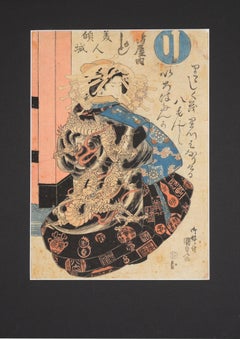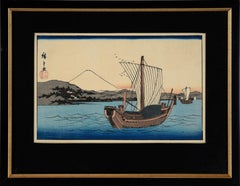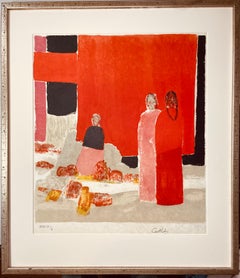Rice Paper Figurative Prints
to
1
Overall Width
to
Overall Height
to
1
15
5
3
3
2
1
1
1
1
1
1
1
1
4
2
1
1
1
1
Artist: Bernard Cathelin
Medium: Rice Paper
Les Mexicaines, Modern Lithograph on Rice Paper by Bernard Cathelin
Located in Long Island City, NY
Artist: Bernard Cathelin, French (1919 - 2004)
Title: Les Mexicaines
Year: circa 1975
Medium: Lithograph on Japon paper, signed and numbered in pencil
Edition: 24/50
Image Size: 21.5...
Category
1970s Modern Rice Paper Figurative Prints
Materials
Rice Paper, Lithograph
Related Items
The Courtesan Kashiwagi and the Kamuro Wakano - Japanese Woodblock Print
Located in Soquel, CA
The Courtesan Kashiwagi and the Kamuro Wakano - Japanese Woodblock Print
Original Toyokuni III/Kunisada (Japanese, 1786 - 1864) Japanese Woodblock Print
"The Courtesan Kashiwagi and...
Category
1820s Realist Rice Paper Figurative Prints
Materials
Printer's Ink, Rice Paper, Woodcut
Kiyomi Barrier & Seiken Temple Near Okitsu- Japanese Woodcut Print on Rice Paper
Located in Soquel, CA
Kiyomi Barrier & Seiken Temple Near Okitsu - Japanese Woodcut Print on Rice Paper
Woodblock print of boats in a harbor by Utagawa Hiroshige (Japanese, 1797-1858). Originally publish...
Category
1850s Impressionist Rice Paper Figurative Prints
Materials
Rice Paper, Woodcut
$1,550
H 15.5 in W 19.25 in D 1.25 in
Japanese Original Woodblock Print
Located in Soquel, CA
Japanese Original Woodblock Print
Harunobu Suzuki (né Hozumi) (Japanese, 1724 - 1770)
Presented in a black mat.
Mat: 16"H x 12"W
Paper: 12"H x 9"W
I...
Category
18th Century Edo Rice Paper Figurative Prints
Materials
Ink, Rice Paper, Woodcut
Actor as Samurai - 18th Century Japanese Woodblock Print
Located in Soquel, CA
Actor as Samurai - 18th Century Japanese Woodblock Print
Woodblock print depicting an actor, possibly Nakamura Denkuro II, as a samurai. The actor stands with his sword unsheathed a...
Category
Late 18th Century Edo Rice Paper Figurative Prints
Materials
Woodcut, Rice Paper
$750
H 19 in W 12.5 in D 0.63 in
"Lady Holding a Baby" - Woodblock Print on Laid Rice Paper
Located in Soquel, CA
"Lady Holding a Baby" - Woodblock Print on Laid Rice Paper
Elegant woodcut print by Stephen White (American, b. 1939). In an early example of White's signature style, a stylized, mi...
Category
1970s Modern Rice Paper Figurative Prints
Materials
Rice Paper, Woodcut
$1,700
H 32 in W 24 in D 0.25 in
"Various Himochi" Wagashi Festival Japanese Woodblock Print by Utagawa Toyokuni
Located in Soquel, CA
"Various Himochi" Wagashi Festival Japanese Woodblock Print by Utagawa Toyokuni
Rare oversized early 19th century 5-tiered woodblock by Utagawa Ichiyosai Toyokuni, (Japan, 1769-1825), a Japanese lord and wife oversee a sekku festival of food, music, and dolls or toys. '"oshi" is the first day of “Mi (Snake)” in the third month of the lunar calendar. This day, known in modern Japan as the Girls' Festival, originated in China as a form of purification ceremony in which water and drinking peach blossom wine were used to drive away evil. Many kinds of hishi-mochi appear in this picture of hina ningyo (dolls associated with Hinamatsuri, or the Girl’s Day) from Omochae.
The custom of eating special dishes at events throughout the year and at milestones in people's lives has existed since ancient times. This paragraph specifically focuses on the annual event called sekku, and life events that involve eating sweets. Joshi is the first day of “Mi (Snake)” in the third month of the lunar calendar. This day, known in modern Japan as the Girls' Festival, originated in China as a form of purification ceremony in which water and drinking peach blossom wine were used to drive away evil. According to the Keiso saijiki, in ancient China, on the third day of the third lunar month, people ate “ryuzetsuhan,” which is the juice of gogyo (Jersey cudweed) mixed with rice flour and nectar. In Japan, there is a record in the Heian period history book Nihon Montoku tenno jitsuroku [839-5] that it was an annual event to make kusamochi using gogyo on the third day of the third month of the lunar calendar, which may have been influenced by Chinese customs.
The tradition of eating kusamochi on the third day of the third month of the lunar calendar continued after that. By the Edo period, however, hishimochi had come to be used as a sweet to serve on the third day of the third month. A picture of a hishimochi is included in the Morisada manko , which we mentioned in Part 1. According to it, hishimochi in the Edo period were often three layers of green-white-green instead of the now common red-white-green. However, it is possible to see from our collection that not all hishimochi were made in this way. Omochae published in 1857, is a good example. Omochae is a type of ukiyoe print...
Category
1820s Edo Rice Paper Figurative Prints
Materials
Ink, Rice Paper, Woodcut
$1,850
H 26.75 in W 21.75 in D 0.25 in
"The Kaminarimon at the Kanseon Temple in Asakusa" - Original Japanese Print
Located in Soquel, CA
"The Kaminarimon at the Kanseon Temple in Asakusa" - Original Japanese Print
Japanese Print "The Kaminarimon at the Kanseon Temple in Asakusa", from the series "Famous Places in Ed...
Category
1850s Showa Rice Paper Figurative Prints
Materials
Rice Paper, Woodcut
$850
H 14 in W 18 in D 1 in
"First Horse Day, 1896" - Chiyoda Palace - Japanese Woodblock by Chikanobu Yoshu
Located in Soquel, CA
"First Horse Day, 1896" - Chiyoda Palace - Japanese Woodblock by Chikanobu Yoshu
Colorful and expressive court scne by Toyohara Chikanobu,"Yoshu" (Japanese, 1838-1912).
This is the r...
Category
1890s French School Rice Paper Figurative Prints
Materials
Ink, Rice Paper, Woodcut
$875
H 15 in W 10.5 in D 0.5 in
Stage 48 of the 53 Stages of the Tokaido - Japanese Woodblock on Rice Paper
Located in Soquel, CA
Stage 48 of the 53 Stages of the Tokaido - Japanese Woodblock on Rice Paper
Woodblock print of clothing vendors by Utagawa Hiroshige (Japanese, 1797-1858). Originally printed in 183...
Category
1830s Impressionist Rice Paper Figurative Prints
Materials
Rice Paper, Woodcut
$1,550
H 15.5 in W 19.25 in D 1.25 in
"House Cleaning in Preparation for the New Year" - Japanese Woodblock on Paper
Located in Soquel, CA
"House Cleaning in Preparation for the New Year" - Japanese Woodblock on Paper
House cleaning scene by Kitagawa Utamaro (Japanese, 1753-1806). This print was originally published around 1796-1799, with this example being a later reprint. The full scene is five sheets - there are two more sheets to the right that show more members of the house. However, it is these three sheets that contain the majority of the action - a maid sweeping at a mouse, a lady fainting, and a painting moved aside to allow for cleaning.
Presented in a new black mat.
Mat size: 24"H x 38"W
Paper size: 17.75"H x 33"W
Print Impression: 14.63"H x 29.5"W
Utamaro Kitagawa...
Category
18th Century Edo Rice Paper Figurative Prints
Materials
Rice Paper, Woodcut
$1,150
H 24 in W 38 in D 0.25 in
One Hundred Prints Of The Noh - 1925 Original Japanese Woodblock Print
Located in Soquel, CA
One Hundred Prints Of The Noh - 1925 Original Japanese Woodblock Print
Original Japanese woodblock print by Tsukioka Kogyo (Japanese, 1869...
Category
1920s Edo Rice Paper Figurative Prints
Materials
Ink, Rice Paper, Woodcut
$710
H 24 in W 18 in D 0.5 in
Women in a Garden
Located in Austin, TX
Tohoyara Chikanobu
"Women in a Garden"
Woodcut print on Paper
Tryptich totalling 13 x 29"
Framed size 20 x 35"
The triptych of woodcut prints features a classic scene of a garden in...
Category
Late 19th Century Rice Paper Figurative Prints
Materials
Rice Paper, Woodcut
Previously Available Items
"Les Mexicaines" / "Mexicans"
Located in Berlin, MD
Bernard Cathelin (French 1919-2004) "Les Mexicaines" Colored Lithograph on Rice Paper.
A peaceful impressionistic scene of three Mexican women in the street.
Red. Orange. Black. W...
Category
Late 20th Century Abstract Impressionist Rice Paper Figurative Prints
Materials
Rice Paper, Lithograph
Rice Paper figurative prints for sale on 1stDibs.
Find a wide variety of authentic Rice Paper figurative prints available on 1stDibs. While artists have worked in this medium across a range of time periods, art made with this material during the 21st Century is especially popular. If you’re looking to add figurative prints created with this material to introduce a provocative pop of color and texture to an otherwise neutral space in your home, the works available on 1stDibs include elements of red and other colors. There are many well-known artists whose body of work includes ceramic sculptures. Popular artists on 1stDibs associated with pieces like this include Leonard Baskin, Bernard Cathelin, Zane Fix, and Toyohara Kunichika. Frequently made by artists working in the Contemporary, Surrealist, all of these pieces for sale are unique and many will draw the attention of guests in your home. Not every interior allows for large Rice Paper figurative prints, so small editions measuring 0.04 inches across are also available
Recently Viewed
View AllMore Ways To Browse
E J Cygne
Early California Mission Paintings
Ebbets Field
Edith Thayer Cromwell
Edmund F Ward
Edna Manley
Eduardo Roca
Edward B Gay
Edward Hopper Oil Painting
Edward Simmons
Edwin Lord Weeks
Elizabeth Enders
Elizabeth Horning
Emil Holzhauer
England Church Oil Painting
English Deer Painting
English Fox Hunt Painting
English Toy Terrier


